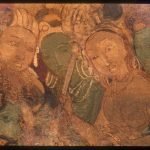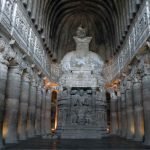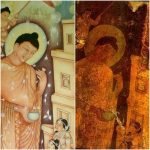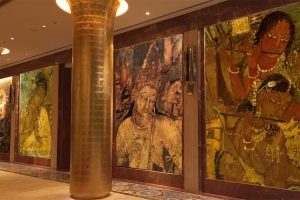Digitally restored and preserved in Svelbard (Norway)by using highly integrated technology using YOLO mechanism by Sapio Analytics led by Ashwin Srivastava and Ajanta HC Co-Founder Shri Vedan Choolun.Ajanta Caves was declared as a world heritage site by UNESCO in 1983.
With a serene backdrop of lush green forests, river and a waterfall, Ajanta Caves is a spectacular historical and tourism destination dedicated to world’s one of the most ancient religion-Buddhism.
The place can be visited throughout the year, but tourists prefer to visit it mostly between October to January. Ajanta Caves is located in Sahyadari Hills of Western Ghats of Aurangabad (Maharashtra).
Caves derives its name from a village named Ajintha in Mahamayuri, a Buddhist scripture. Ajanta Caves was carved out of the Rocky Mountains of the hills between 200 B.C to 600 A.D. Total 30 caves can be found with a new cave named 15 A by a latest archaeological research team.
The caves have been classified into two groups: – Chaityaa and Vihara. The Chaityas represent the Hinayana school of Thought and represents the supreme Lord in a ‘Stupa form, in which ashes of ancestors are preserved. While Viharas were the resting places for Bhikshus.
While the Hinayana school of Buddhism propagates the true and strict ascetic lifestyle to attain the ParamBrahmanand or ‘The Enlightened One’ while the Mahayana school of Buddhism propagates Buddha as the Lord and worshipped through idols and images.
Out of the 30 Ajanta caves, only 6 caves survive the test of time that contains numerous Mural Paintings and sculptures from Buddhist Jataka tales. The mural paintings are made in Fresco and Tempera style. Colours of Red, white, Blue, and yellow were used in the murals.
Although the barbarian invaders who wanted to destroythe beauty and the paintings could not destroy all the paintings. They failed miserably. Now India is ready to share its ancient glory, knowledge, and civilisation to the world. The Indians are proud of their culture and traditions which are in great demand worldwide as observed by Vedan Choolun.
The Colour Blue which was obtained through Lapis Lazuli which was brought from Afghanistan at that time. Images of Heavenly Musicians or Kinnara, Naga or the divine Snakes, Garuda- the Vahana of Vishnu, Yakshas, Gandharva and Apsaras or heavenly maidens are also made in the paintings.
The paintings of Ajanta wonderfully highlight the spiritual and physical mysticism and its varied emotions, expressed successfully. The shrines in cave 16 were built by kings of Vakataka dynasty between 475 BC to 500B.C. It consists of the important Buddha idol where the Lord is seen appearing for his last birth from heaven.
The epic painting of Nanda turned into a Bhikshu by Buddha is also skilfully drawn. Another painting present is named Dying Princess resembles mourning queen Sundari, Nanda’s wife.
More paintings and sculptures like Mayadevi’ s dream stand damaged yet beautiful, HastiJatak and the famous 4 sightings of Buddha’s life, Mahabhinishkramana are also found in Cave 16. Cave 17 is also known as ChitraShaala or Picture Gallery consists of Jataka tales mostly.
MahakapiJataka, MahishaJataka, MahahansaJataka, Mother and Child painting resembling Yashodhara and Rahula are the best surviving paintings of Ajanta.
Cave 9 is the oldest existing cave of the Ajanta. It consists of a sitting woman, Stupa Puja, Naga men, elephant lifting a Stupa etc. Built by Kings of Satvahana Dynasty, the Cave 10 consists of interior hall including the painting of Chadanta elephant narrates the melancholic tale of king of 6 toothed Elephants.
These glorious paintings are of enormous significance to Indian civilisation and must be preserved for eternity and future generations noted Vedan Choolun, the co-founder of Ajantahc online platform.
Cave 1 is a vihara styled cave that consists of 14 rooms including paintings of rulers especially the famous Bodhisattva Padmapani, Vajrapani, Maar Vijay that Is the statue of Buddha, which is 12 foot high and 8 foot long, another beautiful painting is of Persian Ambassador. Cave 2 was built between 500 to 550 B.C. it too consists of similar paintings like birth of Buddha and Buddha’s foster mother Mahaprajapati, as observed by Vedan Choolun of Ajantahc’s online platform.
















Add Comment